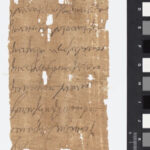| Artefact ID | 152 |
| TM ID | TM 35415 |
| Findspot (DEChriM ID) | 58 (Dayr al-ʿIẓām) | Class | Textual |
| Material | Papyrus |
| Writing medium | Sheet/roll |
| Text content | Documentary |
| Language | Greek |
| Archive/Dossier | Archive |
| Description | P.Herm. 17 verso: Letter to Apa John from a widow. The letter, written on the backside of a re-used document, is complete. It was sent by Leukis, widow, to ask Apa John to get the Goths out of her house. Although it is short and written in bad Greek, it shows signs of rhetorical formulas and literary pretensions. This is one of many Greek and Coptic letters addressed by monks, clerics, soldiers, state officials and individuals to Apa John, so that he would intercede in their favour in dealings with the authorities or pray for them. The anchorite of this archive was identified with the famous John of Lykopolis known by literary sources by Zuckerman 1995. The letter is written in a large sloping hand, along the fibres, as was the first letter written on the recto. |
| Selection criteria | Mention of Christian individuals/communities, Christian terms/formulas/concepts |
| Date from | 375 |
| Date to | 399 |
| Dating criteria | Palaeographically dated to 5/6th c. in the ed. pr., but Zuckerman (1995: 188) re-dated it to 4th c., arguing that the first text on the recto could also be dated 4th c. rather than 6th as suggested in ed.pr. (comparison with P.Neph. 3 suggested by Jean Gascou). He adds that the Goths, billeted at the widow's house, could belong to the Gothic unit dispatched to Egypt by Theodosius I c. 379. |
| Absolute/relative date | Relative date |
| Archaeological context | According to Constantine Zuckerman's reconstruction, the Apa John’s letters were presumably found in September 1897, during the excavations of Farag Ismael and Yassa Tadros on the mountain of Siout (Lykopolis), in the ruins of Dayr al-'Azam, the site of the monastery of John of Lycopolis. Yet they never reached the museum in Gizeh like the other objects unearthed during these excavations, and must have ended on the market, where they were bought soon after the excavations (Zuckerman 1995: 191-192; Van Minnen 1994: 80-82, Gonis 2008: 69-72). Although not proven, this attractive hypothesis is generally accepted by scholars (see discussion in Van der Vliet 2015: 166-167, and some reservations in Choat 2017: 37-40). |
| Accession number | Manchester, John Rylands Library, P.Herm. 17
|
ARTEFACT IDENTIFIERS
Editio princeps:
• Rees, Brinley R. 1964. Papyri from Hermopolis and Other Documents of the Byzantine Period. Egypt Exploration Society, Graeco-Roman Memoirs 42. London, no. 17.
Additional bibliography:
• Bagnall, Roger S. and Raphaella Cribiore. 2006. Women's Letters from Ancient Egypt, 300 BE–AD 800. Ann Arbor: The University of Michigan Press, 204.
• Choat, Malcolm, and Maria Chiara Giorda. 2017. Writing and Communication in Early Monasticism. Texts and Studies in Eastern Christianity 9. Leiden, Boston.
• Gonis, Nikolaos. 2008. “Further Letters from the Archive of Apa Ioannes.” Bulletin of the American Society of Papyrologists 45, 69-85.
• Van der Vliet, Jacques. 2015. “Snippets from the Past: Two ancient sites in the Asyut Region: Dayr al-Gabrawi and Dayr al-’Izam.” In Christianity and Monasticism in Middle Egypt, ed. Gawdat Gabra and Hany Takla. Cairo: The American University in Cairo Press, 161-168.
• Van Minnen, Peter. 1994. “The Roots of Egyptian Christianity.” Archiv für Papyrusforschung und verwandte Gebiete 41, 71-85.
• Zuckerman, Constantine. 1995. "The Hapless Recruit Psois and the Mighty Anchorite, Apa John." Bulletin of the American Society of Papyrologists 32, 183-194.


 Json data
Json data





